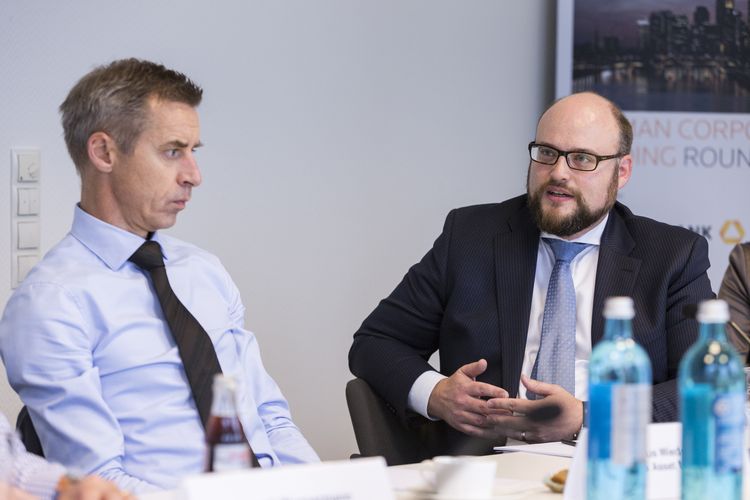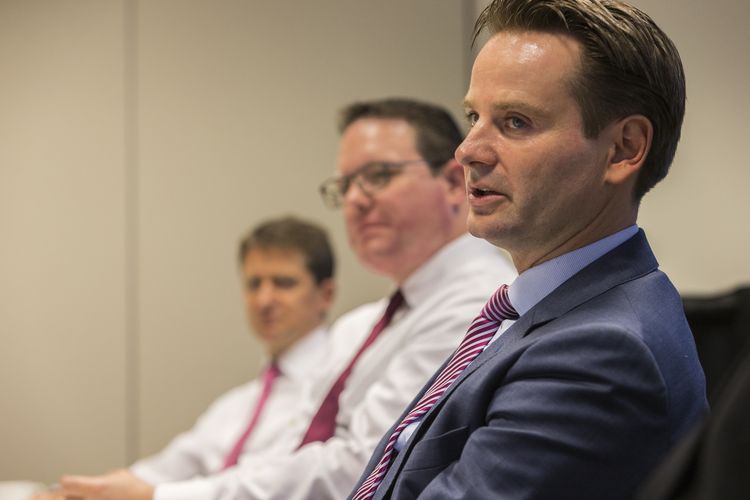Keith Mullin, KM Capital Markets: Welcome to IFR’s seventh Annual German Corporate Funding roundtable. To get the discussion going, I wanted to start by reviewing activity across the various debt classes in 2017. The past year has had a lot of moving parts: geopolitical events, national political events, continuing but different-speed central bank stimulus, and the continuation of negative rates in some parts of the curve.
The banking sector has of course had myriad new and yet-to-be-implemented regulatory issues to deal with. Dominik, how would you characterise 2017 from the perspective of the loan market?
Dominik Müller, Commerzbank: The German loan market was characterised by a decent level of activity in 2017 although market volumes of almost €100bn by the end of the third quarter were 30% less than volumes in the same period of 2016. However if you deduct last year’s €57bn Bayer/Monsanto acquisition financing, volumes in Germany are actually 20% higher than last year.
Where does this growth come from? Looking at overall market maturity profiles at the end of last year, you wouldn’t have anticipated much activity in 2017. But contrary to expectations, a variety of companies came to the market from across the corporate spectrum: multinationals, DAX 30 companies as well as companies from the Mittelstand segment.
Particularly in the Mittelstand area, there were a lot of small-cap companies tapping the market for the first time. We had already seen this over the last few years but it continued into 2017. Those transactions don’t add much to overall market volumes but they do obviously increase the number of transactions.
We also saw a decent number of medium-sized acquisition financings. In summary, the market was much better than anticipated by many market participants at the beginning of this year but far weaker than in top years.
Keith Mullin, KM Capital Markets: Not that the loan market is insensitive but it tends not to react in the knee-jerk way that securities markets do to events. I presume that hasn’t changed.
Dominik Müller, Commerzbank: That’s right. The banking market, particularly in the corporate space, is relationship-driven. Banks take a long-standing view on corporate clients. External shocks and other special situations occur regularly but in general there has basically been no impact on the loan market in the recent past.
Keith Mullin, KM Capital Markets: To Dominik’s point, Ingo, the bond market does react, sometimes with intense volatility, to certain events. But in spite of all of the event-risk and potentially destabilising factors, I can’t think of any point during 2017 in the bond market where latent fears have really upset the market; it’s been fairly sanguine. How would you characterise the year in the bond market? Would you attribute its nominal calm to the fact that rates are where they are, and that has been driving sentiment rather than events?
Ingo Nolden, HSBC: Definitely. If I were to boil it down to the most relevant factor: it’s Mario Draghi. It’s QE and the abundant liquidity that has painted all volatility out. The bond market is experiencing the super-tanker effect where if you want to slow down even if you don’t put any more coal on the fire will go on for a few more kilometres.
This is where we are at the moment. I would go as far as to say that the past year has been a boring year. OK we’ve seen things happening around us that have had everybody scratching their heads but basically it didn’t have any real impact. We are in an artificial environment driven by central bank liquidity. In Germany people talk about an overheating economy, we have a booming real estate market and ECB executive board member Sabine Lautenschläger saying she would have had applauded a more aggressive move out of QE.
So as in the last year, the German side of things is a little concerned about the liquidity situation. Of course you can say it works, it works perfectly well in markets where we have volatility points. At the moment you could say it’s happy days.
Christian Reusch, UniCredit: The bond market has been looking at so many events over the last 12 months. It even focused on Austrian presidential elections. In the past this probably wouldn’t have been a bond market event. The same with Dutch elections, then French elections etc. We might look at these events but if I look back over the last 18 months the only thing which cost maximum 72 hours of high volatility was Brexit and even that was digested very quickly.
This perhaps gives the impression that markets are too complacent but looking at things from the borrower’s point of view, conditions haven’t been better. The market is about to hit absolute lows. Bankers keep saying that and I’m sure Henryk will say he’s heard this over the last couple of years.
But then each year markets go even lower on both rates and spreads. I think we have more or less found the bottom now. Waiting for those last 5bp to 10bp would not, from my perspective, be the wisest decision.
It’s rather the opposite: cash generation is high but people don’t know where to put their money, both on the borrower side and the investor side. Everybody feels tempted about aggressively cheap levels but at the same time nobody wants to run negative carry.
That’s the next big topic, which is already on a lot of people’s minds when you see the first RFPs coming in, which is: “OK, if I do this now, where can I deposit my money and what are you willing to pay?” This is the discussion we’re currently having with borrowers and it’s certainly an interesting one.
Keith Mullin, KM Capital Markets: Dominik, from your perspective focusing on the German experience, we have near-perfect conditions, low rates and low volatility. Are you comfortable with the level of issuance we’ve seen?
Dominik Buric, LBBW: We’ve had a very solid year in bonds with substantial new issuance volume. German automotive companies have done around €32bn this year, which accounts for more than half of the German corporate bond market. So the share of automotive issuers has clearly been above historic average. Overall, we saw an environment that has been easy to handle from the borrower’s side with only a few transactions experiencing difficulties timing-wise.
If you look at the Schuldschein market as a different, private market (though less so nowadays) we’ve seen a lot of new corporate borrowers. This year has seen a clear trend to first-time issuers. And it’s an important trend. We are going to see roughly 150 transactions this year. It’s a mature funding source for corporate borrowers, and for investors it’s a great diversification tool to gain exposure both to large and mid-sized companies at a decent spread level.
Anthony Bryson, BNP Paribas: All the nails have been hit on the head so far and I agree with what’s been said. People have been getting very excited about the unrated bond market, about Schuldschein etc. But let’s keep some perspective: the US has around US$1.3trn in new-issue supply while EMEA investment-grade corporates are approaching US$300bn this year, which is a very good volume historically.
The Schuldschein market – excluding private deals that are not captured – is typically in the €10bn to €20bn range, more €20bn than €10bn. The unrated bond market in Europe is somewhere between €10bn and €20bn, more towards €10bn this year. So let’s not get too excited about an attractive regional market. It’s important but let’s not forget the big picture.
I am still forming a view on the next year because it has not always been easy to predict the market these last few years but it doesn’t matter since whatever you look at, whether it’s hybrids – take for example the hybrid by Danone with a 1.75 % coupon – iTraxx Main or Crossover, it’s all gone tighter. Look at any heat map showing where government bonds are. It’s mostly red, meaning negative yields. What else have we got? Investment-grade corporate new-issue premiums somewhere between zero and 5bp, VIX that was at 18 one year ago but a tad over nine now; WTI around US$44 in the summer but now north of US$57.
With all of this, I don’t know if we should worry about unknown unknowns. Is it all too good to be true, the DAX 30 around 13,500 [at the time of the discussion on November 7], the S&P 500 north of 2,500? None of the events we’ve seen this year have moved the needle. You would have thought that some of them would have. Against this background, it is difficult not to be constructive looking forward.
Ingo Nolden, HSBC: Could it be the calm before the storm?
Anthony Bryson, BNP Paribas: Yes, but we said that two years ago as well.
Ingo Nolden, HSBC: That’s the problem.
Anthony Bryson, BNP Paribas: Henryk will know this. He always hears the same story and then it gets tighter and tighter, right?
Christian Reusch, UniCredit: As I said, it’s the risk of being too complacent. Everything seems to be too good to be true without any risks of making mistakes. I think the real difference in today’s market is as long as you’re not aiming for multi-tranche it’s just simple timing, that’s all. The artificial discussion as to whether the starting point for a new issue is here or there or whether to employ a strategy of approaching investors with a bold message from the beginning or with wider IPT and then try to piggyback on a strong book to tighten that in, is just a bit more art than science.
Keith Mullin, KM Capital Markets: Henryk, so you live in a perfect world. Can you explain your mindset and strategy in terms of how you look at the capital markets?
Henryk Wuppermann, E.ON: The first topic is always corporate development ie, do you need the funds? If you don’t, it doesn’t make sense to raise them. Obviously at E.ON we’ve had a large corporate reshuffling with the spin-off and listing of Uniper and then we reached the nuclear waste storage deal with the German government, which forced us to pay €10bn in July.
There are several topics out there related to debt issuance but corporate development always has the primary impact. If you do disposals you don’t do them for funding but the funding comes with it. Same goes for acquisitions. Because the markets are so good, you don’t need to worry a lot about them. You can do whatever is required on the corporate side, which is a good situation to be in.
Keith Mullin, KM Capital Markets: Do near-perfect funding conditions put pressure on management teams to do things they wouldn’t ordinarily do, be it event-driven activity or other corporate strategic things?
Henryk Wuppermann, E.ON: Not really. Investors or shareholders always want to get the best out of the company but that doesn’t really depend on the capital markets or whether the interest rate is 1%, 2% or 3%. Obviously it’s relative performance we provide to our investors against those levels.
To see the digital version of this roundtable, please click here.
To purchase printed copies or a PDF of this report, please email gloria.balbastro@tr.com.

